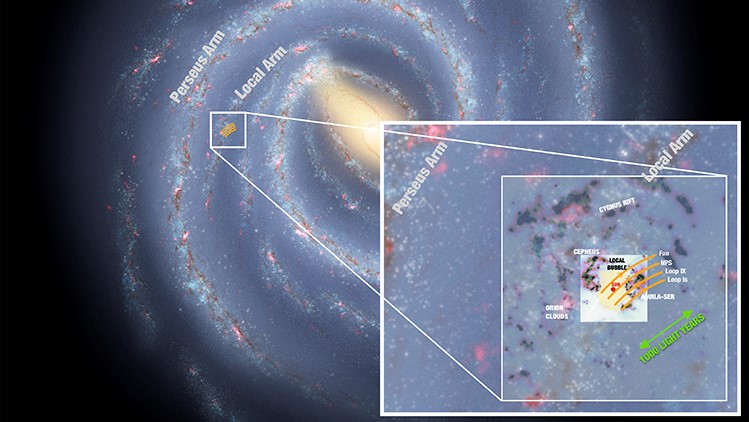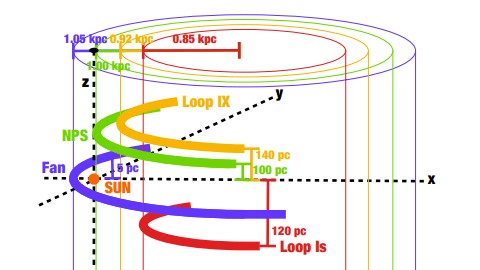Earth may be trapped inside a giant magnetic tunnel
The magnetic ropes may surround our planet.

Our planet, along with the rest of the solar system and some nearby stars, may be trapped inside a giant magnetic tunnel — and astronomers don't know why.
A tube of vast magnetized tendrils, 1,000 light-years long and invisible to the naked eye, may encircle the solar system, astronomers propose in a new paper. Jennifer West, an astronomer at the Dunlap Institute for Astronomy and Astrophysics at the University of Toronto, made the proposal after an investigation into the North Polar Spur and the Fan Region — two of the brightest radio-emitting gas structures in our galactic neighborhood — revealed that the two structures might be linked even though they are located on different sides of the sky.
"If we were to look up in the sky, we would see this tunnel-like structure in just about every direction we looked — that is, if we had eyes that could see radio light," West said in a statement.
Related: The 12 strangest objects in the universe
The curving tendrils — which are made of both charged particles and a magnetic field, and resemble long, thin ropes — project outward from the North Polar Spur and the Fan Region. Not only could the strange cosmic ropes link the two regions, but they could form something akin to "a curving tunnel" where the tendrils are like "the lines formed by the tunnel lights and road lane marker," the researchers said.
This would place our solar system along with a small chunk of the Milky Way, inside the giant magnetic tunnel.
The North Polar Spur, which appears as an enormous yellow cloud stretching above the plane of our galaxy, is a gigantic crest of gas emitting X-rays and radio waves. The Fan Region is less understood but produces a lot of polarized radio waves. Though these unusual regions in space were discovered in the 1960s, scientific understanding of them remains patchy, and most previous studies described each structure separately.
Breaking space news, the latest updates on rocket launches, skywatching events and more!
But by plugging data from radio wave observations into a new computer model, West and her colleagues mapped out the probable length and position of the gigantic ropes. The model estimated that the ropes were roughly 1,000 light-years long and that the structures were most likely about 350 light-years from the solar system.
West says that the inspiration for her model came when she was a student, seeing the tendrils upon her first inspection of a map of the radio sky. Years later, she was told of a 1965 paper which speculated on the strange radio signals.
"Based on the crude data available at this time, the authors (Mathewson & Milne) speculated that these polarized radio signals could arise from our view of the Local Arm of the galaxy, from inside it," West said in the statement. "That paper inspired me to develop this idea and tie my model to the vastly better data that our telescopes give us today."
It's not just in our part of the universe that these cosmic filaments have been spotted. In fact, they're ubiquitous throughout the galaxy and can radiate many different types of light. The researchers note in their study that filamentary structures have been seen emitting optical light near remnants of gigantic stellar explosions, or supernovas; in molecular clouds; and in the walls of "galactic chimneys" — enormous cavities created by multiple supernova explosions, through which hot gas from the galactic disk flows to the galactic halo. In fact, some studies have even gone as far to suggest that spiraling filaments of molecular gas could be the "bones" that form the "skeleton" of the Milky Way.
The scientists' next steps are to confirm their findings by taking detailed observations of the regions they simulated, and to then use those observations to refine their model. West hopes that, by deepening the model, she can improve astronomers' ability to understand other magnetic filaments spotted around our galaxy. Another intriguing possibility is that the invisible magnetic ropes could be a small part of a much larger galactic structure.
"Magnetic fields don't exist in isolation. They all must connect to each other," West said. "So a next step is to better understand how this local magnetic field connects both to the larger-scale galactic magnetic field and also to the smaller-scale magnetic fields of our sun and Earth.
"I think it's just awesome to imagine that these structures are everywhere, whenever we look up into the night sky," West added.
The researchers published their findings Sept. 29 on the preprint server arXiv, which means it has yet to be peer reviewed.
Originally published on Live Science.

Ben Turner is a U.K. based staff writer at Live Science. He covers physics and astronomy, among other topics like weird animals and climate change. He graduated from University College London with a degree in particle physics before training as a journalist. When he's not writing, Ben enjoys reading literature, playing the guitar and embarrassing himself with chess.




